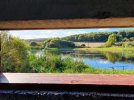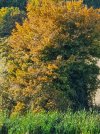- Location
- Southport
Currently in Majorca and have seen plenty of Hoopoes, but not a lot else yet.
I was absolutely delighted to find this page and read through this thread. In my youth and in youger years I was a so called twitcher but moving to Germany changed this as twitching is a britsh passion that only a minority here in germany partake in.Seen a stunning hawk flying around our garden over the last few weeks. A good 3-4 foot wingspan and fantastic to watch as it swoops around the trees. Happened to be on a conference call looking out of our dressing room window this afternoon and there it was, sitting at the top of a pine tree about 30 feet from the window. I managed to get one photo of it before it flew away but what an incredible predator. My first thought was a female sparrowhawk but it seemed both too big and the tail too short. Any experts here?
 My biggest obsession these days is my garden list, this Hawfinch this week way afiirst in the sense of the Garden.I am particularly proud of my wood pecker list, 5 species so far . The Three toed Woodpecker is supposed tobe returning to myarea of the black forest, but I have not had much luck with that one. The beauty of the black forest is the abundance of black woodpeckers, beautiful birds.
My biggest obsession these days is my garden list, this Hawfinch this week way afiirst in the sense of the Garden.I am particularly proud of my wood pecker list, 5 species so far . The Three toed Woodpecker is supposed tobe returning to myarea of the black forest, but I have not had much luck with that one. The beauty of the black forest is the abundance of black woodpeckers, beautiful birds.I was absolutely delighted to find this page and read through this thread. In my youth and in youger years I was a so called twitcher but moving to Germany changed this as twitching is a britsh passion that only a minority here in germany partake in.
First to the bird in the picture. One of the keys to bird identification is knowing the gist of birds, perched or sitting. On this bird there are a number of very clear identification features but also confusing . Confusing. The bird is quite elegant and not stocky. Buzzards are usually dumpier, the bird has a more horizantal posture than vertical, the neck is also more protruding than hunched. The defining factor however is the distance of the primary feather tips to the end of the tail which identifies this clearly as a Buzzerd.
To the other suggestions, going alone on GIST, Honey Buzzard, Osprey and Red Kite are relively easy to eliminate. Goshawk again the ratio wing feathers to tail.
But more importantly to the term twitching.
Twitchers are a small part of the birding community.
In the old days it was bird watchers, but the americans have the cooler term, birder, which is what anyone serious about birdwatching and wants to be cool would call themselves a birders.
Twitchers are the fanatics with lists, they are not necessarily concerned with the fine points of identification but more on adding speciae to their list.
The word twitching refers to their nervous state they get in in anticiapation of seeing a bird not on their list, this stops if they see the bird and if they dip (fail to see the bird) then the disappointment is incredible.
Birds are broken down inot the following categories
Megaf****ers this is probaböy the equivalent to Romanée Conti or Petrus. A twitcher must go for these.
Rarities, list on BB list where identification has to be confirmed. These usually occur yearly or every few years
Scarcities. This is more at a local level, and needs local confirmation from the regions bird recorder.
All species, pretty common but in these days nothing is pretty common.
Bill Oddie wrote a great book on this.
Paul 100% male sparrowhawk. Goshawnk has definitive white eye stripe.I was beginning to wonder why I hadn't seen many small birds at my feeders recently.............
View attachment 29795
I think its a reference to Dan's picture that opens this thread... but the most recent raptor pic is absolutely a super specimen of male sparrowhawk!I was a twitcher too in my mid teens. What really put me off was a pipit or lark which could only be fully identified by catching it and measuring the second and third flight feathers, that and deciding I’d rather hang around the pub looking for “birds”than around a wet and cold marsh looking for a small brown bird in a large brown bush. Shallow I know.
I now really enjoy watching birds casually and have seen spoonbills and hoppees in Gran Canaria this week. There a Canarian chiff chaff behind our room which I haven’t seen it yet.
If we’re looking at the same picture it a sparrow hawk, male.










Paul 100% male sparrowhawk. Goshawnk has definitive white eye stripe.
plus I agree on the change of title /thread.
Great story Andrew. I have been taking my 7 year old grandson on birdwatching trips for a few years now and bought him his first pair of 'proper' binoculars last year. I hope that it has triggered a lifelong interest in birding and he often talks about our trips and makes plans for our next ones. We are currently on a kingfisher search as we have only ever seen one briefly (I have seen many in France, but it was also my first sighting in the UK, only 2 years ago). His other big desire is to see a Golden Eagle in the wild and I would love to be there with him when he sees his first one.Here's a touching story. Up until the death of my grandmother in 1998, for as long as I can remember my paternal grandparents lived in the village of Sprotbrough, near Doncaster in South Yorkshire. Whenever we visited, without fail every day my grandfather would take us for a walk around the Sprotbrough Flash nature reserve, a patch of woodland and meadows flanked by the river Don on one side, the Flash (a shallow lake) on the other, and an old quarry and disused railway line along a third edge. It is where I saw many firsts, a weasel, a kestrel, and towards the later years, my first kingfisher.
God, it’s grim oop North, i’n’t it?Here's a touching story. Up until the death of my grandmother in 1998, for as long as I can remember my paternal grandparents lived in the village of Sprotbrough, near Doncaster in South Yorkshire. Whenever we visited, without fail every day my grandfather would take us for a walk around the Sprotbrough Flash nature reserve, a patch of woodland and meadows flanked by the river Don on one side, the Flash (a shallow lake) on the other, and an old quarry and disused railway line along a third edge. It is where I saw many firsts, a weasel, a kestrel, and towards the later years, my first kingfisher.
Anyhow, I have not been back since 1998, although often tempted, but it's a long way to go for a walk. However with a new job about to begin I finally took the plunge last October, during a bloom of Indian summer warmth and drove the 3 hours from Reading to Sprotbrough. Memories of course came flooding back, old tree trunks, yew tree groves, the sounds of pheasants in the meadows and so on. The bird hides had changed, possibly a result of covid, having had their back walls removed, but broadened out as a result and reinforced with concrete as opposed to the creosoted wood of old. There seemed to be a lot of birding activity, lots of khaki outfits and telephoto lenses, and I asked if something was up. It turns out that the Flash has become something of an osprey hangout and I'd arrived at feeding time.
I was late for my return drive but, like all obsessive personalities, was determined to stick it out... and lo! The young osprey appeared, wheeled around a few times, found a perch and waited. And then it went fishing. I didn't have a camera but one kind soul allowed me to take a picture of his efforts... below the pics of a beautiful walk..
View attachment 29828View attachment 29829View attachment 29830View attachment 29831View attachment 29832View attachment 29833View attachment 29834View attachment 29835View attachment 29836View attachment 29837
